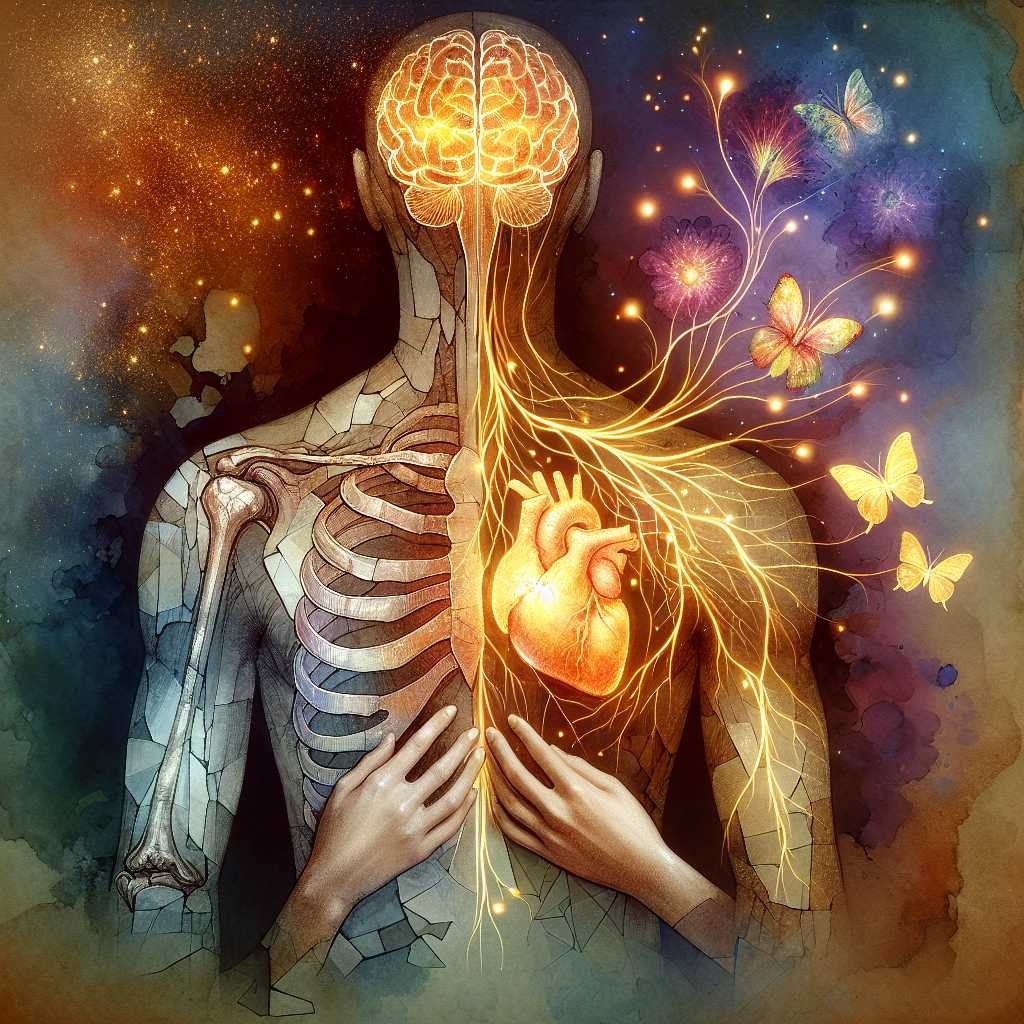The Body Keeps the Score (Kindle Edition) by Bessel van der Kolk: A Practical, Science‑Backed Guide to Healing Trauma
If you’ve ever wondered why anxiety shows up as a tight chest or why a loud noise can send your whole body into fight‑or‑flight, you’re not alone. Trauma doesn’t live only in our memories—it lives in our nervous system, our muscles, our sleep patterns, and even our relationships. That’s the central insight of The Body Keeps the Score by Bessel van der Kolk, M.D., a landmark book that has shaped how clinicians, caregivers, and trauma survivors understand recovery.
This review breaks down the book’s big ideas in plain language, translates the science into everyday metaphors, and shows you how to use the Kindle edition to learn, highlight, and revisit what matters. Think of this as your friendly field guide to the most influential trauma book of the last decade—what it gets right, how to use it, and where to go next.
What “The Body Keeps the Score” Is About—And Why It Matters
The Body Keeps the Score argues a simple but profound truth: traumatic stress changes the brain and the body, which is why healing must engage both. Dr. van der Kolk, a leading trauma researcher and clinician, draws on decades of work with survivors of abuse, combat veterans, accident survivors, and people harmed in relationships to show how trauma can reshape attention, sensation, emotion, and trust.
Here’s why that matters: if trauma changes how you process danger, safety, memory, and connection, then “just talking about it” may not be enough. Recovery often requires practices that regulate the nervous system, build body awareness, and restore a felt sense of safety.
If you want a portable, highlight‑friendly version while you read along or take notes, Shop on Amazon.
Key Idea 1: Trauma Is a Whole‑Body Experience
The book makes a compelling case that trauma is not only a psychological event; it’s a physiological imprint. When a person experiences threat, the brain’s alarm system—the amygdala—fires, the stress response mobilizes, and the body prepares to fight, flee, or freeze. For many trauma survivors, that system gets stuck “on,” so the body responds to non‑threats as if danger is imminent.
- The amygdala becomes overactive (hypervigilance, startle response).
- The prefrontal cortex (your rational brake pedal) goes offline under stress.
- The hippocampus (memory integration) can misfile traumatic events, producing flashbacks and intrusive images.
This explains why triggers feel so immediate and physical. You don’t “think” your way into a racing heart or a clenched jaw; your nervous system gets there first.
If you’re curious about the clinical background of PTSD, the National Institute of Mental Health has a clear overview of symptoms and treatments you can skim here: NIMH: Post‑Traumatic Stress Disorder.
Key Idea 2: Relationships Can Hurt—And Heal
Dr. van der Kolk emphasizes how attachment and social connection affect trauma’s impact. When trauma involves betrayal, neglect, or violence from trusted people, the nervous system learns that intimacy equals danger. That’s why survivors can feel isolated even in supportive relationships.
The flip side is hopeful: safe, attuned relationships help recalibrate the nervous system. Small moments of co‑regulation—a steady gaze, a calm voice, a hand on the shoulder with consent—tell the body, “You’re safe now.” Therapy matters, but so does community: teammates, peers, support groups, and friends who can be there without forcing a story out of you.
Curious what other readers highlight, underline, and discuss as they move through the book? Check it on Amazon.
Key Idea 3: The Brain Can Change (Neuroplasticity Is Real)
One of the most energizing parts of the book is its focus on neuroplasticity—the brain’s ability to adapt and rewire. That’s not empty optimism; it’s measured in changes to brain activity, hormone levels, sleep, and behavior. Calm breathing, consistent movement, safe touch, and mindful attention can reshape how the nervous system reacts to stress.
- Practices like yoga, tai chi, and breathwork counter shallow, rapid breathing patterns common in traumatic stress.
- Therapies like EMDR (Eye Movement Desensitization and Reprocessing) help the brain reprocess traumatic memories so they stop hijacking the body.
- Neurofeedback trains attention and self‑regulation by giving the brain real‑time information about its activity.
For an accessible overview of how early adversity affects lifelong health and behavior, see the CDC’s introduction to Adverse Childhood Experiences (ACEs).
The Science, Simplified: What’s Happening Under the Hood
Let’s break the neuroscience into a quick map you can carry:
- Amygdala: your smoke detector. In trauma, it fires too fast, too often.
- Prefrontal cortex: your wise coach. Under threat, it loses authority.
- Hippocampus: your librarian of memory. Trauma can scramble the catalog.
- Autonomic nervous system: your gas and brake pedals. Trauma can jam the gas.
In daily life, this might look like: – Jumping at every door slam (hyperarousal) – Feeling numb or detached (dissociation) – Trouble sleeping or concentrating – Getting flooded by emotions or shutting down
The American Psychological Association offers a concise primer on trauma and stress for additional context: APA: Trauma.
What The Body Keeps the Score Recommends for Healing
The book doesn’t push a single cure. Instead, it offers a toolbox. Different people respond to different methods, and often, the most effective approach is a blend.
Evidence‑informed options covered in the book include: 1. EMDR: Uses bilateral stimulation to help reprocess traumatic memories so they’re less disruptive. 2. Yoga and breathwork: Build interoception (awareness of bodily sensations) and teach the body to return to baseline. 3. Neurofeedback: Trains brainwave patterns geared for focus and calm. 4. Somatic therapies: Help you notice and release held tension without reliving the story. 5. Theater, movement, and music: Reclaim play, voice, rhythm, and safe embodiment. 6. Mindfulness meditation: Strengthens attention and emotion regulation.
If you’re curious whether meditation might help regulate arousal and attention, the NIH’s center on integrative health has a helpful overview: NCCIH: Meditation and Mindfulness.
Ready to upgrade your healing toolkit with a copy you can annotate and revisit? See price on Amazon.
Cautions and Care
- Go slow. Trauma work is sensitive. It’s okay to pace yourself, take breaks, and skip sections if you feel activated.
- Work with a trained clinician for processing traumatic memories, especially if you experience dissociation, self‑harm, or severe anxiety.
- Choose body‑based practices that feel safe and titrated (small, doable doses).
- If yoga interests you, this overview from Harvard highlights how movement and breath can ease anxiety and depression: Harvard Health: Yoga for Anxiety and Depression.
Who Should Read This Book?
- Survivors who want to understand why they feel what they feel—and see hopeful paths forward.
- Partners, parents, and friends who want to support someone they love without pushing or pathologizing.
- Clinicians, teachers, and coaches seeking trauma‑informed frameworks and practical tools.
- Leaders and HR professionals interested in psychological safety and recovery‑friendly workplaces.
Want to gift a digital copy to someone who might need it—and receive it instantly? Buy on Amazon.
How to Get the Most from the Kindle Edition
The Kindle version shines for learning and retention. Here are practical ways to use it well:
- Use X‑Ray and search: Jump to terms like “amygdala” or “neurofeedback” fast.
- Highlight and export: Build a notes file to review with a therapist or book club.
- Read in short sessions: Trauma material can be heavy; 10–15 minute chunks help you absorb more.
- Pair with audio: If you have Audible, toggle WhisperSync to switch between reading and listening without losing your place.
- Adjust typography: Larger font and wider spacing reduce cognitive load when emotions run high.
If you’re comparing hardcover, audiobook, and digital for your workflow, View on Amazon.
Buying Tips and Format Considerations
- If you annotate heavily, Kindle is excellent for highlights and sharing notes.
- If you prefer embodied learning, pair reading with a yoga or breathwork app to practice as you go.
- If you’re sensitive to triggering content, the digital format makes it easier to skip sections and return later.
- If you want to read alongside a partner or clinician, syncing across devices helps you pick up anywhere.
Want a format that’s searchable, portable, and easy to revisit during therapy sessions? Check it on Amazon.
What I Appreciated Most (And What to Watch For)
What stands out in The Body Keeps the Score is its humility: healing is not one‑size‑fits‑all. The book respects how diverse histories and bodies require diverse pathways. Its stories are human and varied; its science is thorough; its suggestions are practical. It’s a rare blend of compassion and rigor.
That said, a few notes: – Some interventions (like neurofeedback) may not be accessible everywhere, and results can vary. – The book can be triggering; consider reading with support if certain chapters feel intense. – Trauma research keeps evolving. Complement your reading with current guidelines from trusted organizations or a licensed provider.
For up‑to‑date guidance on trauma and mental health more broadly, the World Health Organization provides global resources: WHO: Mental Disorders – Key Facts.
If you’d like a copy you can highlight and search during therapy or group discussion, Shop on Amazon.
Practical Takeaways You Can Use Today
Even before you finish the book, you can start experimenting with gentle, body‑based strategies. These aren’t cures, and they don’t replace therapy, but they can help you build capacity and safety now.
Try: – Orienting: Slowly look around the room and name five things you see; notice your body on the chair; lengthen your exhale. – Breath pacing: 4‑second inhale, 6‑ to 8‑second exhale, for two minutes. – Grounding through touch: Press feet into the floor or hold something with texture. – Micro‑movement: Shoulder circles, a gentle neck stretch, a slow walk—while paying attention to sensations. – Social connection: Share a quiet moment with someone safe; co‑regulation can be as simple as a calm presence.
Here’s why this matters: when you teach your nervous system that safety is possible in the present, even in small doses, you build the capacity to process the past without flooding. The body learns new rhythms.
A Brief Chapter‑by‑Chapter Lens (Without Spoilers)
Dr. van der Kolk structures the book in a way that moves from understanding to healing:
- Foundations: What trauma does to bodies and brains, and how symptoms emerge.
- Memory and the mind: How we store and retrieve traumatic events.
- Children and development: The long tail of early adversity.
- Treatments and tools: What helps people get their lives back.
This progression makes the book useful for both newcomers and seasoned clinicians: you can skim the science sections or dive deep, then move to practical methods without losing the thread.
How This Book Fits with Therapy and Self‑Help
A book, even a great one, can’t replace personalized care. But it can be a powerful complement:
- It helps you name what’s happening (“Oh, that’s hyperarousal.”).
- It reduces shame by normalizing the body’s adaptations.
- It gives you language to communicate with providers or loved ones.
- It opens doors to interventions you might not have known existed.
If you’re working with a therapist, consider bringing your highlights and questions to session. If you’re DIY‑ing, go slow, prioritize safety and consent, and choose practices that leave you feeling more stable, not less.
Final Thoughts
The Body Keeps the Score has earned its reputation because it speaks to the lived reality of survivors: trauma is not just in your head; it’s in your body—and that means your body can be part of the solution. The Kindle edition makes it easy to carry, annotate, and revisit the insights that resonate. Most importantly, the book replaces self‑blame with understanding and offers realistic paths back to connection, pleasure, and trust. If you read one trauma book this year, make it this one—and let it be a companion, not a burden, on your healing path.
FAQ: The Body Keeps the Score (Kindle Edition)
Q: Is The Body Keeps the Score appropriate for someone new to trauma science? A: Yes. It’s written for general readers and clinicians alike. Expect clear explanations, case examples, and a blend of science and story. If any chapter feels heavy, pause and return when you feel steadier.
Q: Will this book be triggering? A: It can be. The content involves real stories of trauma. Use the Kindle’s search and skip features to move past sections that feel overwhelming. Consider reading with support from a therapist or trusted person.
Q: Is the Kindle edition better than paperback or audiobook? A: It depends on your learning style. Kindle is great for highlights and quick search; paperback works well for visual memory and sticky notes; audiobook can be easier for dense sections but may be more emotional. Many readers pair Kindle with audio for flexibility.
Q: Is the book evidence‑based? A: The author draws on decades of clinical work and research, plus studies on EMDR, neurofeedback, mindfulness, and somatic therapies. For broader context, check resources like NIMH and APA.
Q: Do I need a therapist to use what I learn? A: Not necessarily. Many practices—breathwork, gentle movement, mindfulness—are accessible on your own. For trauma memory processing or if you experience severe symptoms, work with a licensed clinician.
Q: What are some practical practices I can try right away? A: Start with slow exhalations, grounding through your senses, short walks with attention to your feet, and brief, nonjudgmental check‑ins with your body. Keep doses small and consistent.
Q: Who will get the most from this book? A: Survivors seeking understanding, loved ones who want to support, and professionals who want a deeper, more humane lens on trauma and healing.
Q: What should I read next after this? A: Consider trauma‑informed works that emphasize the nervous system and attachment, as well as practical guides on mindfulness, yoga, or EMDR. Pair your reading with embodied practice for best results.
Actionable takeaway: Healing grows when the body learns safety in small, repeatable moments. Pick one gentle practice today—longer exhales, a short mindful walk, or three minutes of stillness—and let your nervous system practice coming home. If you found this useful, stick around for more trauma‑informed guides and book breakdowns.
Discover more at InnoVirtuoso.com
I would love some feedback on my writing so if you have any, please don’t hesitate to leave a comment around here or in any platforms that is convenient for you.
For more on tech and other topics, explore InnoVirtuoso.com anytime. Subscribe to my newsletter and join our growing community—we’ll create something magical together. I promise, it’ll never be boring!
Stay updated with the latest news—subscribe to our newsletter today!
Thank you all—wishing you an amazing day ahead!
Read more related Articles at InnoVirtuoso
- How to Completely Turn Off Google AI on Your Android Phone
- The Best AI Jokes of the Month: February Edition
- Introducing SpoofDPI: Bypassing Deep Packet Inspection
- Getting Started with shadps4: Your Guide to the PlayStation 4 Emulator
- Sophos Pricing in 2025: A Guide to Intercept X Endpoint Protection
- The Essential Requirements for Augmented Reality: A Comprehensive Guide
- Harvard: A Legacy of Achievements and a Path Towards the Future
- Unlocking the Secrets of Prompt Engineering: 5 Must-Read Books That Will Revolutionize You







